SWOT Analysis: How to Actually Use It
If you’re stepping into the world of business analysis, or just trying to make smarter decisions, you’ll want SWOT analysis in your toolkit. It’s one of those simple frameworks that can completely change how you approach problems, opportunities, and goals. All explained through simple real-life SWOT analysis examples.
In this guide, we’ll cover:
- What SWOT analysis really is
- When it is useful
- Advantages and disadvantages of SWOT
- A deep dive into strengths, weaknesses, opportunities, and threats
- Real-world SWOT analysis examples
- How to use AI to draft your SWOT
What is SWOT analysis?
SWOT stands for:
- Strengths
- Weaknesses
- Opportunities
- Threats
It is visualized as a 2×2 matrix that helps you brainstorm and organize internal and external factors impacting a project, business, or even your personal career plans.
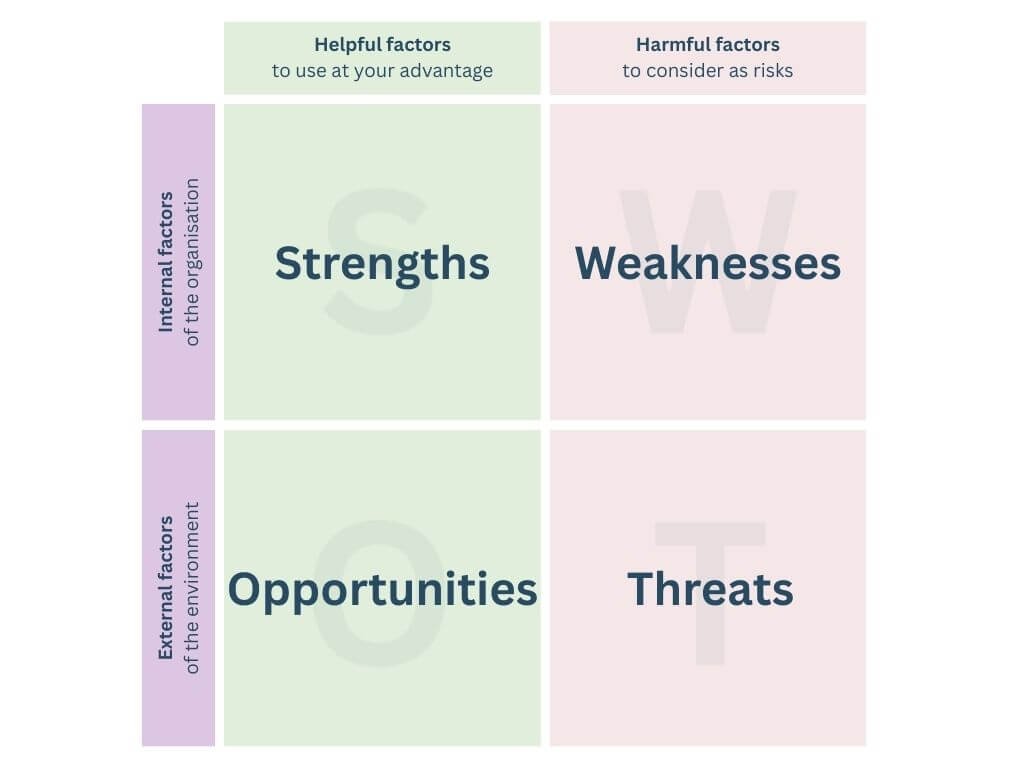
On the horizontal you will need to place:
- Internal factors – Strengths and weaknesses
- External factors – Opportunities and threats
The verticals, on the other side, you are showing the positives and negatives within the analys:
- Helpful factors – Strengths and opportunities
- Harmful factor – Weaknesses and threats
Whether you’re analyzing a startup idea, a marketing campaign, or your next career move, a SWOT can help you see the full picture before making decisions.
When is it useful to create a SWOT analysis?
A SWOT analysis is not just for massive corporations or big project launches – it’s incredibly versatile. You should think about doing a SWOT:
- when you’re at the start of a new project or strategic initiative
- during quarterly or annual planning sessions
- when entering a new market or launching a new product
- as part of competitor benchmarking
- when reassessing internal capabilities or risks
- When you want to evaluate your personal and professional development
Basically, anytime you’re facing uncertainty, change, or opportunity, taking a pause to map out a SWOT can help you make a smarter, more confident move.
Advantages and disadvantages of SWOT analysis
Advantages:
- Simplicity. Anyone can do a SWOT, there is no need for special software, degrees, or consultants.
- Broad application.Works for businesses, personal goals, nonprofits, startups… You name it.
- Holistic view. Forces you to consider both internal and external factors.
- Prioritization. Helps you quickly see what deserves attention right now.
Disadvantages:
- Subjectivity. It’s easy to inject personal biases into the process.
- Oversimplification. Complex problems might need deeper analysis beyond just a 2×2 grid.
- Static snapshot. The world changes fast. A SWOT can become outdated if not revisited regularly.
- Not action-focused by itself. Without turning insights into specific strategies, a SWOT alone won’t bring progress towards your goals.
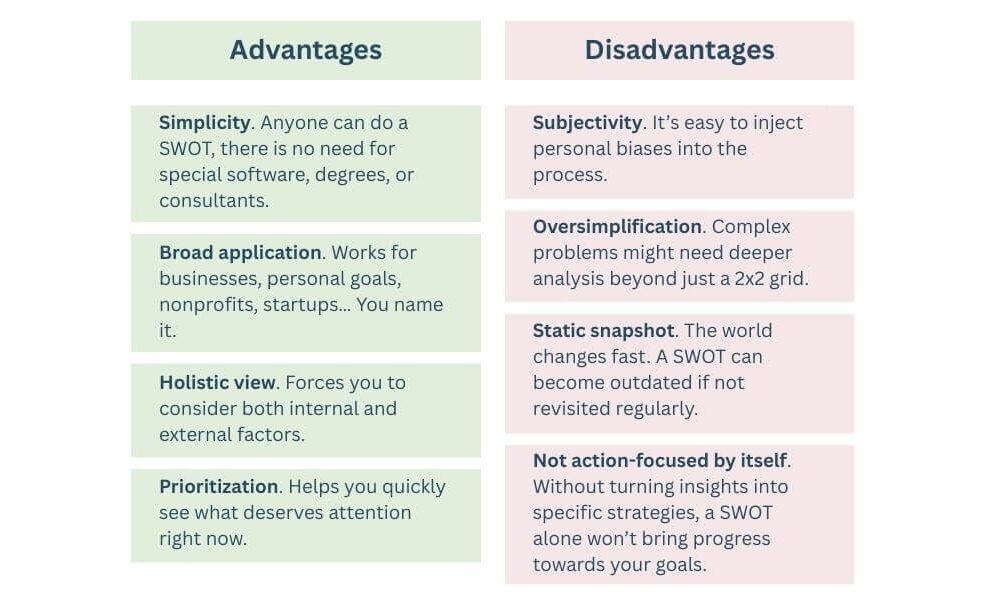
SWOT analysis components
Strengths in SWOT analysis
When we talk about strengths in SWOT analysis, we mean the internal attributes that give you (or your business) an advantage. These could be things like brand loyalty, proprietary technology, strong leadership, or even personal traits like resilience.
Example:
If you’re a small software company, your strengths might include:
- An agile team that quickly adapts
- Deep expertise in a niche market
- Strong relationships with loyal customers
Pro Tip:
Be honest but also confident. Many people underplay their strengths, but spotting and leveraging what you already do well is half the game.
Weaknesses in SWOT Analysis
This is the part where you have to be a little tough on yourself (or your business). Weaknesses are internal factors that put you at a disadvantage. It could be anything from outdated technology to lack of experience or even poor brand visibility.
Example:
For a small business, weaknesses might include:
- Limited marketing budget
- Overdependence on one big client
- Lack of technical scalability
Pro tip:
Don’t get discouraged! Every business or individual has weaknesses. A good SWOT analysis just makes you aware of them so you can address them.
Opportunities in SWOT Analysis
Opportunities in SWOT analysis refer to external chances for growth, expansion, or improvement. These are factors in the world around you—market trends, customer needs, technological advancements—that you can take advantage of.
Example:
If you’re launching a health app, your opportunities might include:
- Rising interest in remote health monitoring
- Increased smartphone penetration globally
- New government programs promoting fitness initiatives
Pro Tip:
Train yourself to spot hidden opportunities by staying on top of industry trends, listening to customers, and thinking creatively about unmet needs.
Threats in SWOT Analysis
Threats in SWOT analysis are external risks that could impact your success. These could be things like economic downturns, new competitors, regulation changes, or even shifting consumer preferences.
Example:
For an online store, threats could include:
- A major retailer launching a similar product
- New privacy laws affecting customer data handling
- Changing social media algorithms reducing your ad reach
Tip:
Plan ahead. Identifying threats early gives you time to pivot, innovate, or develop a Plan B.
Identify internal and external factors for the SWOT analysis
If you are having a tough time identifying the points for the SWOT analysis, it’s worth doing a bit of prep work to make sure you’re basing it on real insights, not just gut feelings. Here are a few relevant tools you could use.
Start with Internal Analysis:
- Resource Audit. Take into account everything you have – skills, technology, people, brand reputation, finances. Knowing what resources you’re working with makes it easier to pinpoint strengths and weaknesses.
- VMOST Analysis (Vision, Mission, Objectives, Strategy, Tactics). Check that your business or personal goals are clear. If you know exactly where you’re headed and how you plan to get there, you’ll spot misalignments or gaps much faster.
Then move to External Analysis:
- PESTLE Analysis (Political, Economic, Social, Technological, Legal, Environmental): Scan the big outside world for anything that could open up opportunities or create threats for you.
- Porter’s Five Forces: Zoom in on your specific industry or market. Are new competitors popping up? Are suppliers calling the shots? Is customer loyalty fragile? This helps you see competitive threats and opportunities more sharply.
By pulling insights from these tools first, your SWOT analysis will be way more grounded, strategic, and useful—not just a brainstorm session that gets forgotten a week later.
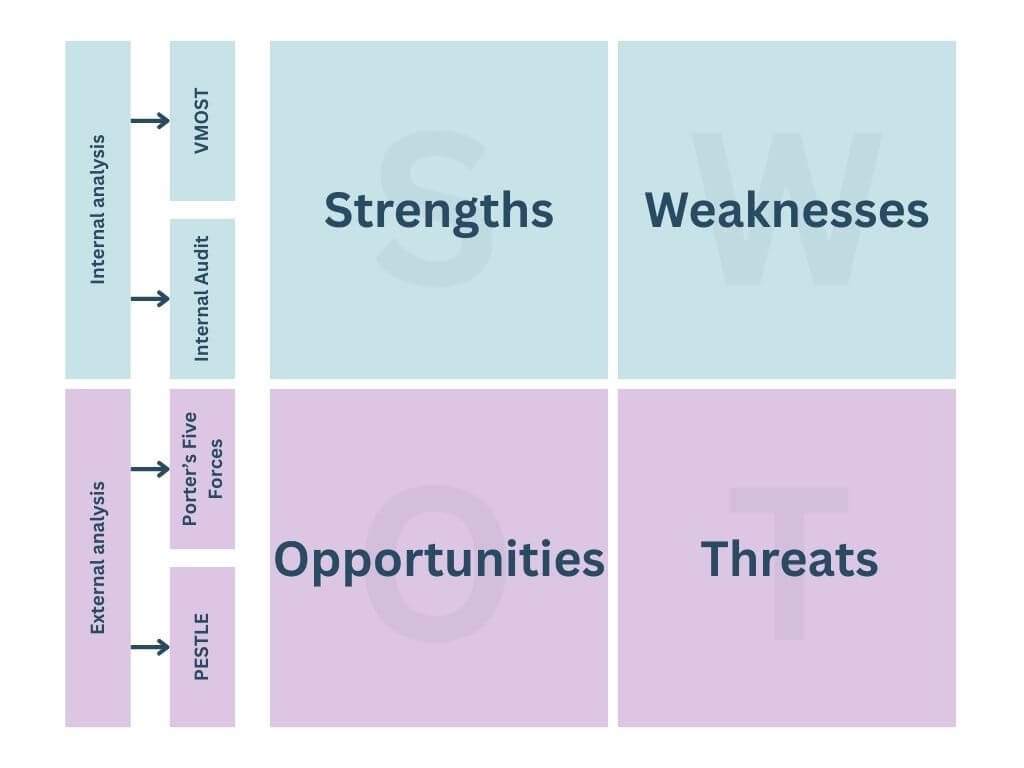
Real-life SWOT analysis examples
Here’s how SWOT analysis looks in action:
1. SWOT Analysis of Technology in Education
| Strengths | Weaknesses |
| Enhances learning accessibility | Not all students have access to tech |
| Personalized learning opportunities | High infrastructure costs |
| Enables remote education | Teachers may lack technical training |
| Opportunities | Threats |
| Rising demand for online learning | Cybersecurity risks |
| EdTech innovations like VR/AR | Resistance from traditional educators |
| Global e-learning expansion | Widening educational inequalities |
2. SWOT Analysis of Technology in Business
| Strengths | Weaknesses |
| Automation boosts productivity | High tech implementation costs |
| Enhanced customer engagement tools | Skills gap in existing workforce |
| Data-driven decision-making | Risk of tech dependency |
| Opportunities | Threats |
| AI and ML adoption | Cyber threats and hacking |
| Global reach through e-commerce | Rapid tech obsolescence |
| Cloud scalability | Increasing regulatory scrutiny |
3. Personal SWOT Analysis Example
| Strengths | Weaknesses |
| Great communicator | Limited project management experience |
| Analytical and detail-oriented | Need for technical certifications |
| Fast learner | No previous BA role |
| Opportunities | Threats |
| High demand for business analysts | Competitive job market |
| Availability of free BA trainings | Risk of burnout |
| Remote job opportunities | Economic hiring freezes |
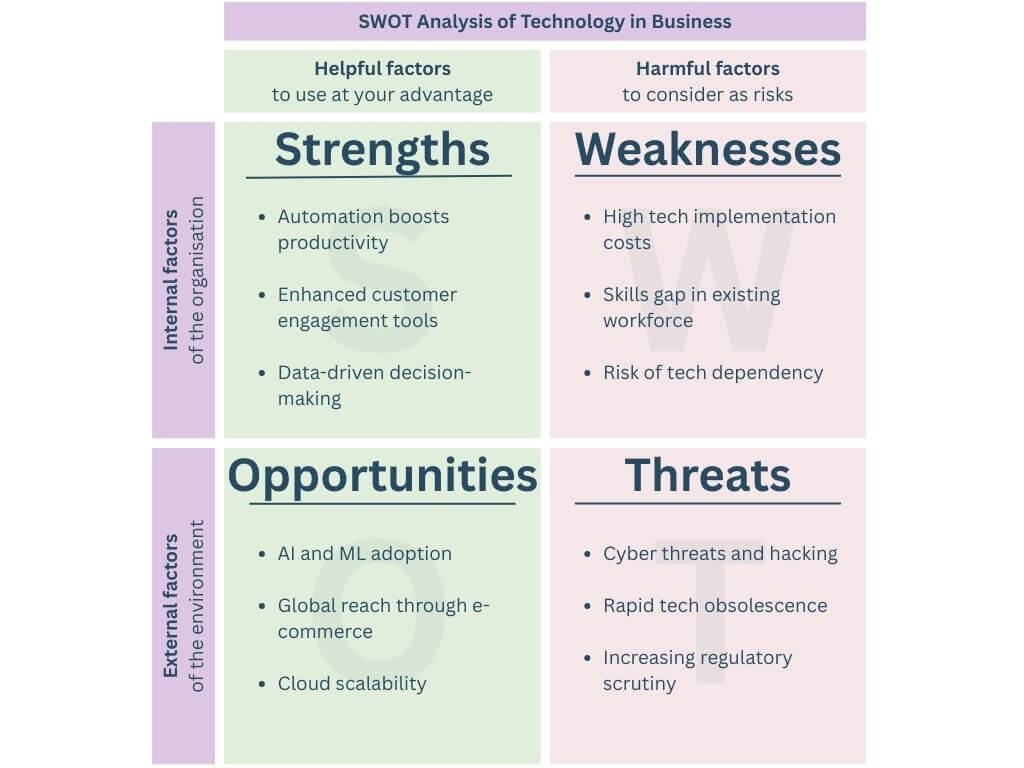

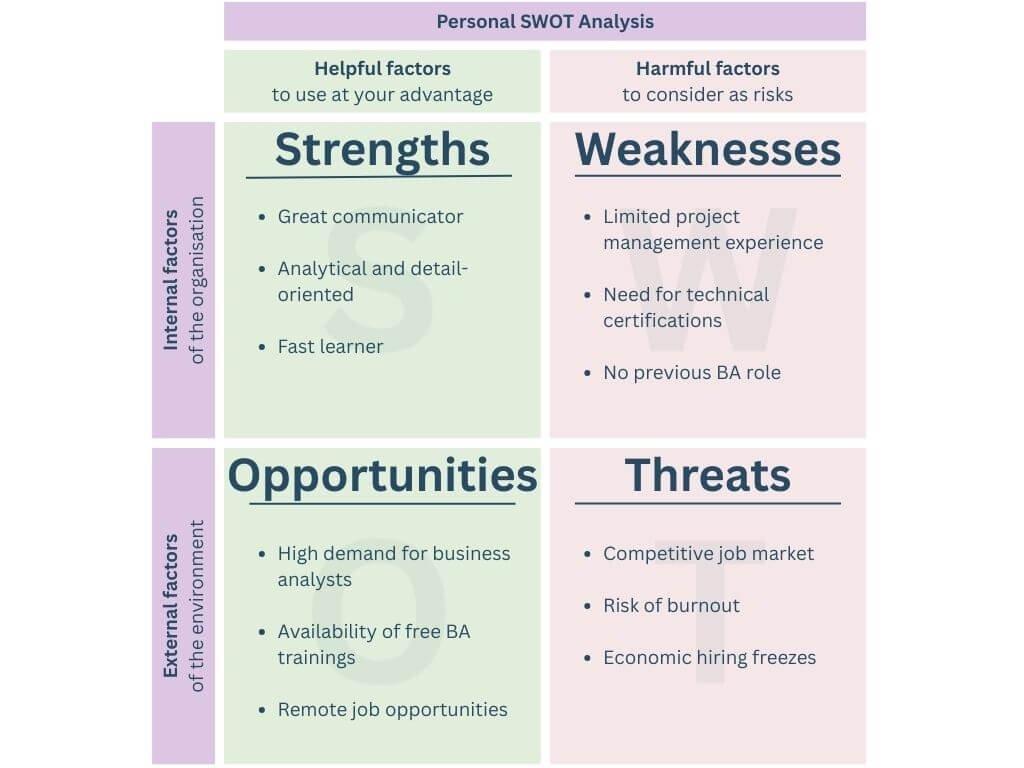
Sample AI prompts for SWOT analysis
One of the easiest ways to kick off a SWOT brainstorming session? Use AI!
Here are a few sample prompts you can use to generate SWOT analysis fast:
“Generate a SWOT analysis for a startup offering AI-powered personal finance tools.”
“Create a SWOT analysis for a mid-sized healthcare tech company expanding internationally.”
“Draft a personal SWOT analysis for someone transitioning from teaching to UX design.”
“List potential threats and opportunities for a new mobile e-commerce platform targeting Gen Z consumers.”
“Identify strengths and weaknesses for a family-owned bakery looking to expand into online sales.”
Pro Tip:
Always personalize the AI output based on your actual situation. Think of it as a starting draft, not a final answer.
Conclusion: Why You Should Start Using SWOT Today
Whether you’re analyzing a booming tech trend, planning your next career leap, or launching a side hustle, a SWOT analysis helps you make smarter, more strategic decisions.
It’s not just about brainstorming—it’s about truly understanding your strengths, confronting your weaknesses, chasing your best opportunities, and protecting yourself from threats.
And thanks to AI, building your next SWOT could take minutes instead of hours.
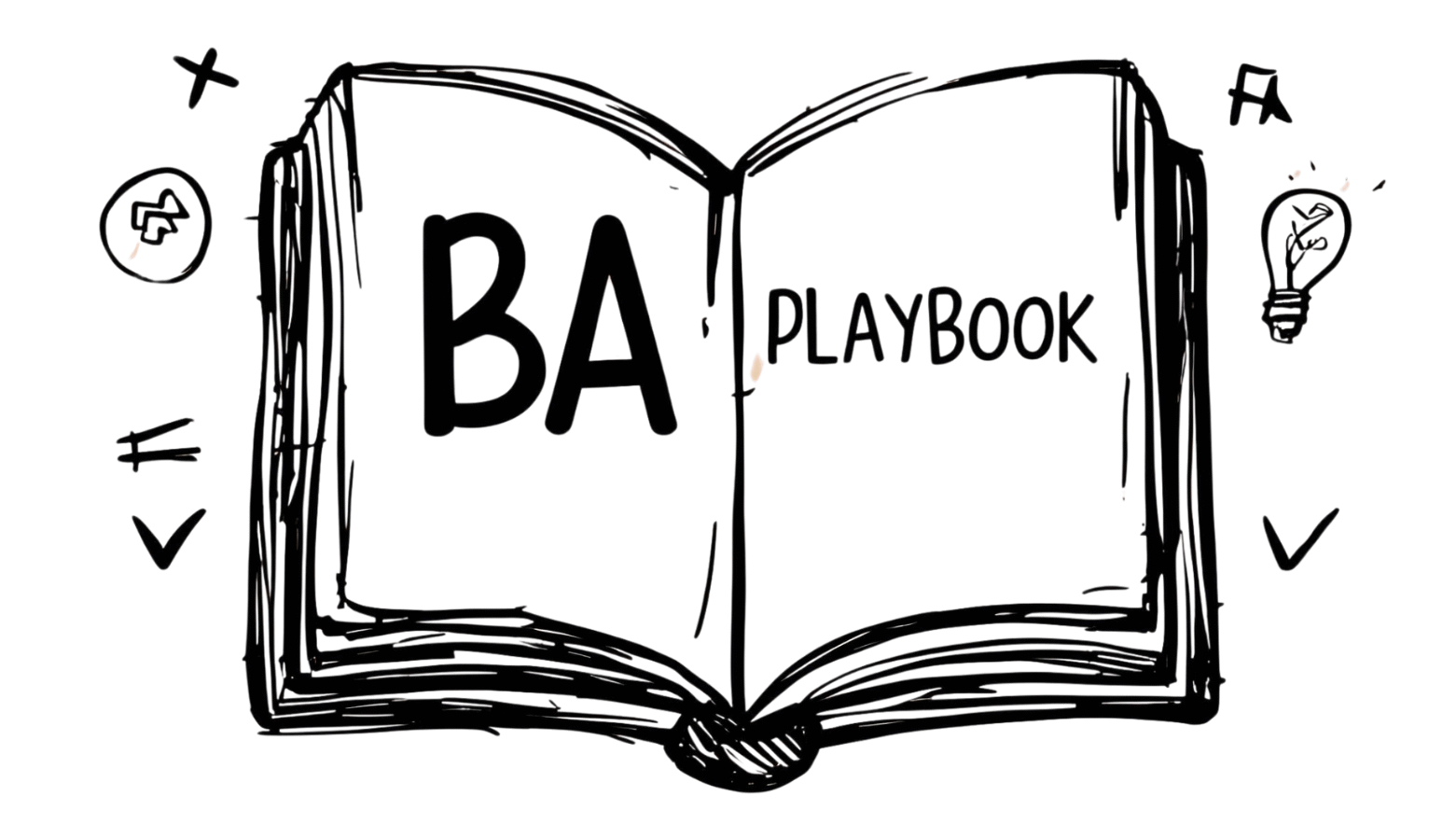



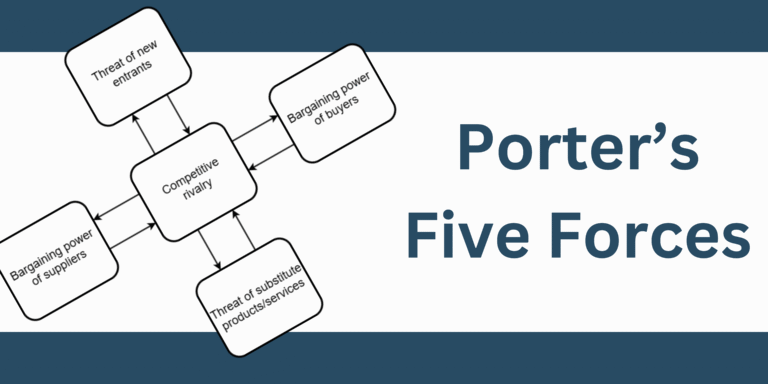
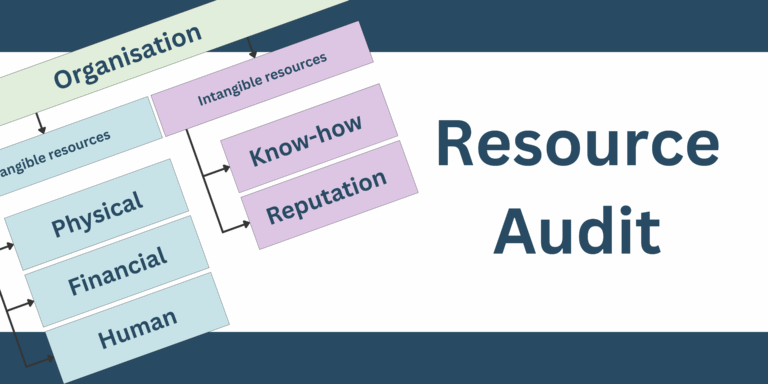
One Comment
Comments are closed.